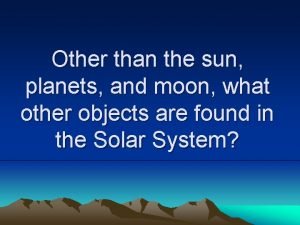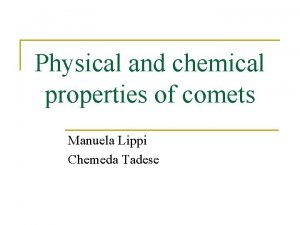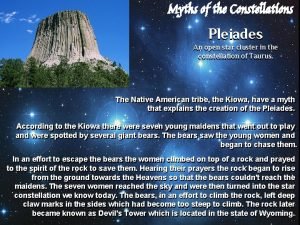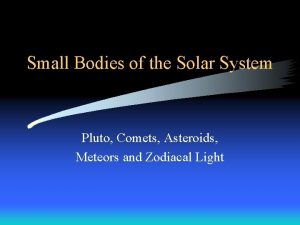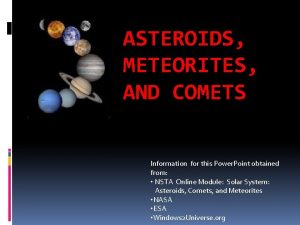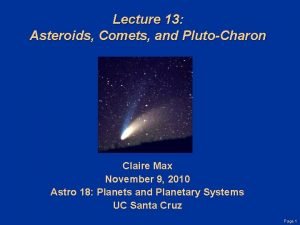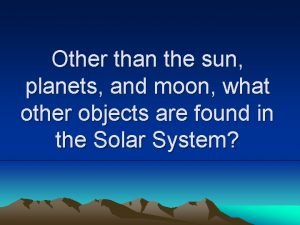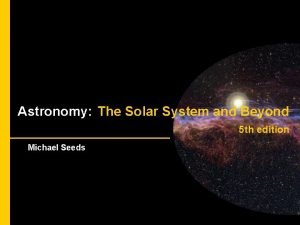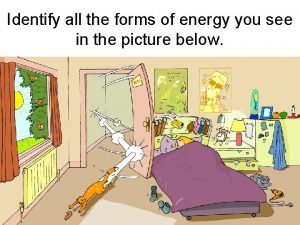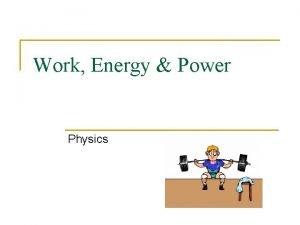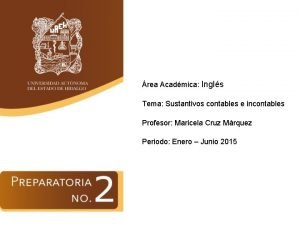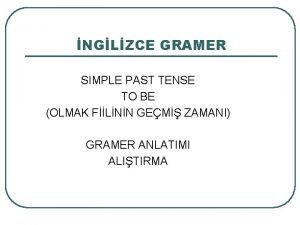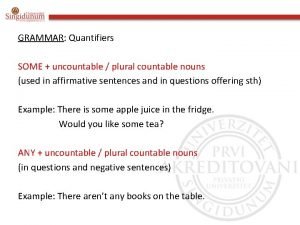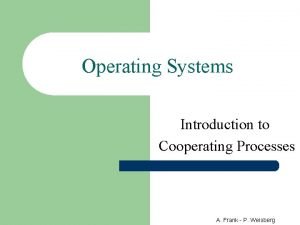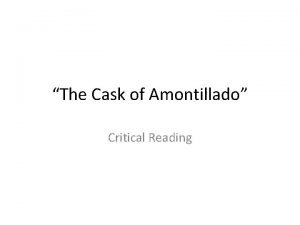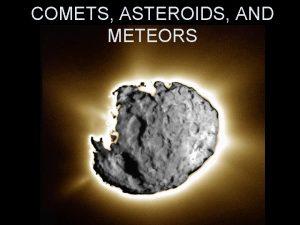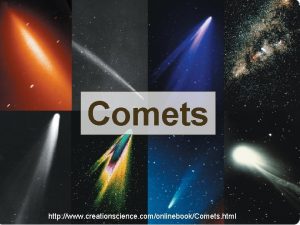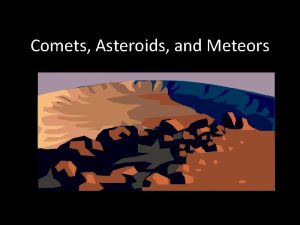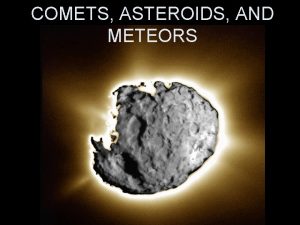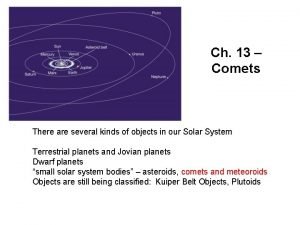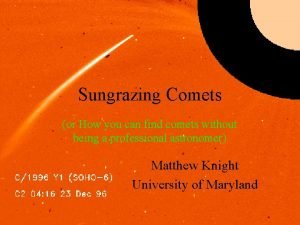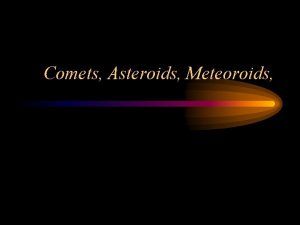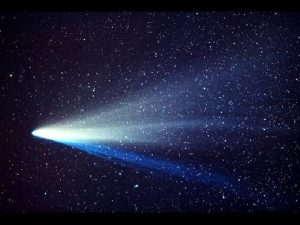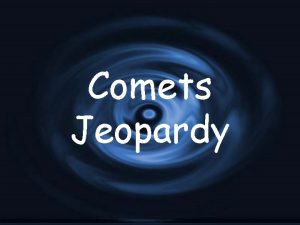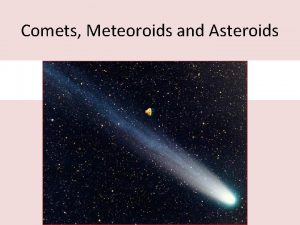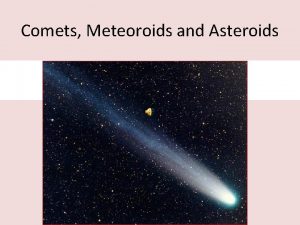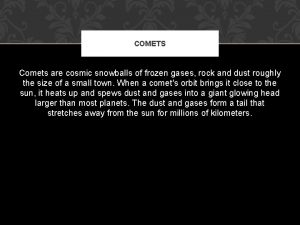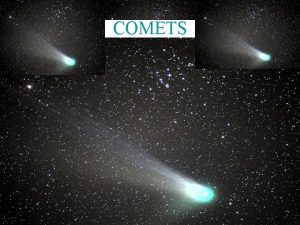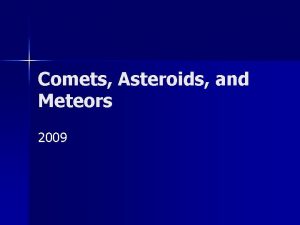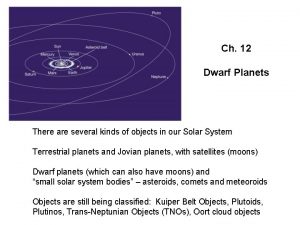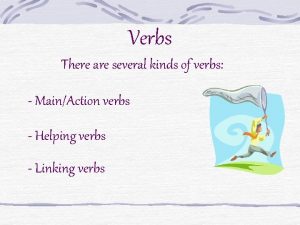Ch 13 Comets There are several kinds of












































- Slides: 44

Ch. 13 – Comets There are several kinds of objects in our Solar System Terrestrial planets and Jovian planets Dwarf planets “small solar system bodies” – asteroids, comets and meteoroids Objects are still being classified: Kuiper Belt Objects, Plutoids

Halley’s Comet was last seen in 1986. The orbital period is about 76 years, so it will be back in 2061.

Comet Tails: ion tail and dust tail Comet Hale-Bopp (1997) had two distinctive tails: http: //apod. nasa. gov/apod/ap 050522. html

The hydrogen envelope is much larger than the tails.

The gas tail has more turbulence and variability.


Comet Encke: the ion (or plasma) tail was blown completely off by a Coronal Mass Ejection. See: Astronomy Picture of the Day for 10/3/07 for details http: //apod. nasa. gov/apod/ap 071003. html

A Comet Trajectory is usually a very narrow ellipse, with eccentricity near 1. 0 Some comets appear to come from almost 100, 000 A. U. from the Sun, in a region called the Oort cloud.

Comet Reservoirs: the Oort Cloud the Kuiper Belt (pronounced Kye-per)


Kuiper Belt Objects appear to move relative to the distant stars in images taken hours apart.


Comet Wild, with two images combined to show a heavily-cratered nucleus and the jets of gas.

Halley’s Comet close-up by a passing spacecraft

Nucleus of Comet Borelly, imaged by Deep. Space 1.

The orbit of Sedna is huge compared to even the Kuiper belt, and may extend to the Oort cloud.

A NASA spacecraft, Stardust, went through the tail of comet Wild and obtained samples of dust fragments.

Images of Comet Tempel 1 taken by the Deep Impact Spacecraft.

Comet 67 P/Churyumov–Gerasimenko has been visited by the Rosetta spacecraft which had a lander, Philae.



View of the surface of 67 P from Philae lander. A view of the lander has been superimposed.

Short-period comets result when a comet is deviated from a highly-eccentric orbit by the influence of a Jovian planet. Fragmentation of a comet can occur as it passes Earth.



Ch. 14: Meteors

Meteor Showers are usually due to old comets. There is definite proof that some are due to known comets. Others are probably fragments of asteroids. list of meteor showers: http: //en. wikipedia. org/wiki/List_of_meteor_showers more on meteor showers: http: //en. wikipedia. org/wiki/Meteor_showers


Meteorite – a meteor which reaches the ground Various types: stony, iron-nickel, carbonaceous

Stony meteorites Broken to reveal a dark crust and a rough fracture surface Cut and polished to reveal iron inclusions

Iron meteorites Cut and polished to Reveal crystalline form Rough, as-found

Carbonaceous chondrite meteorite Allende meteorite fragment, found after a fall in Mexico Ruler is 15 cm

Found meteorites - on Arctic Ice

What Killed the Dinosaurs? This is an artistic representation of an asteroid impact in the Yucatan region over 65 million years ago.

Tunguska event, Siberia, June 30, 1908

Tunguska Debris, Siberia, 1908

Barringer Crater in Arizona – a meteor crater

Manicouagan Reservoir: a crater in Canada

Approximate frequency of random impacts

A meteorite fell over Chelyabinsk, Russia on Feb. 15, 2013 Videos of the Chelyabinsk event of 2013 looking up from sidewalk, boom, running and chaos after first minute (4: 45) http: //www. youtube. com/watch? v=b 7 m. LUIDGqmw A 10 minute newscast (in English) with Neil de. Grasse Tyson https: //www. youtube. com/watch? v=_szd 9 B 3 FU 8 Y Videos of blast hitting various locations, mostly taken by indoor cameras (2: 46) http: //www. youtube. com/watch? v=tq 02 C_3 Fv. Fo Mostly outdoor views, from cars and traffic cam (duration 1: 24): (Turn down volume, music added) http: //www. youtube. com/watch? v=90 Omh 7_I 8 v. I&feature=player_embedded An 8 minute newscast (in Russian) http: //www. youtube. com/watch? v=t 3 v. CUdns. Fs 0 A 6 minute newscast (in English) http: //www. youtube. com/watch? v=u. A_o 28 x. F_48 10 minutes of raw video (including most of the above footage) http: //www. youtube. com/watch? v=dpm. Xy. Jrs 7 i. U Some of these will have ads before the video, or on bubbles on top of the video.

Near Earth Objects - NEO There is an automated system to scan the sky for near-Earth objects and report them to a computer system. http: //www. ll. mit. edu/mission/space/linear/ These and other reports are fed into a computer program called the JPL Sentry system: http: //neo. jpl. nasa. gov/risk/ This detected a threat a few years ago, at risk level 2, http: //neo. jpl. nasa. gov/news 149. html which is no longer considered a threat, after new calculations were done. The main NEO page: http: //neo. jpl. nasa. gov/ has various news articles on events of interest as they happen. A longer term threat: Asteroid 1950 DA may collide with Earth in the year 2880 (1 in 300 chance): http: //neo. jpl. nasa. gov/1950 da/

Comets • Many comet nuclei orbit the Sun in the Kuiper belt, a doughnut-shaped region beyond Pluto. Billions of cometary nuclei are also believed to exist in the spherical Oort cloud located far beyond Pluto. • Comet nuclei are fragments of ice and rock often orbiting at a great inclination to the plane of the ecliptic. In the Kuiper belt and Oort cloud they have fairly circular orbits. When close to the Sun, they generally move in highly elliptical orbits. • As an icy comet nucleus approaches the Sun, it develops a luminous coma surrounded by a vast hydrogen envelope. A gas (or ion) tail and a dust tail extend from the comet, pushed away from the Sun by the solar wind and radiation pressure.

Meteoroids, Meteors, and Meteorites • Boulders and smaller rocks in space are called meteoroids. When a meteoroid enters Earth’s atmosphere, it produces a fiery trail, and it is then called a meteor. If part of the object survives the fall, the fragment that reaches Earth’s surface is called a meteorite. • Meteorites are grouped in three major classes according to their composition: iron, stony-iron, and stony meteorites. Rare stony meteorites, called carbonaceous chondrites, may be relatively unmodified material from the primitive solar nebula. These meteorites often contain organic hydrocarbon compounds, including amino acids. • Fragments of rock from “burned-out” comets produce meteor showers. An analysis of the Allende meteorite suggests that a nearby supernova explosion may have been involved in the formation of the solar system some 4. 6 billion years ago. • An asteroid that struck Earth 65 million years ago probably contributed to the extinction of the dinosaurs and many other species. Another impact caused the “Great Dying” of life 250 million years ago. Such devastating impacts occur on average every 100 million years.

Key Terms amino acid Apollo asteroid belt asteroid carbonaceous chondrites coma (of a comet) dust tail (of a comet) dwarf planet gas (ion) tai hydrogen envelope impact crater iron meteorite Kirkwood gaps Kuiper belt long-period comet meteor shower meteorite meteoroid nucleus (of a comet) Oort cloud planet radiation (photon) pressure short-period comet Small Solar. System Bodies (SSSBs) stable Lagrange points stony meteorite stony-iron meteorite Trojan asteroid Widmanstätten Patterns
 Mikael ferm
Mikael ferm Asteroids meteors and comets worksheet
Asteroids meteors and comets worksheet Physical properties of comets
Physical properties of comets Comets diagram
Comets diagram Comets asteroids
Comets asteroids Difference between comets and asteroids and meteors
Difference between comets and asteroids and meteors Comets asteroids
Comets asteroids Name that space rock
Name that space rock Properties of comets
Properties of comets There are several ways
There are several ways Traditional vs organic poem
Traditional vs organic poem There are three kinds of lies
There are three kinds of lies What types of love are there
What types of love are there There are many different kinds of sports
There are many different kinds of sports Mechanical energy examples
Mechanical energy examples Potential energy and work
Potential energy and work How many types of sports
How many types of sports 潛在變項
潛在變項 There are four kinds of sentence
There are four kinds of sentence Direct sentence structure
Direct sentence structure Different kinds of sports
Different kinds of sports Different kinds of letter
Different kinds of letter If there is no struggle there is no progress explanation
If there is no struggle there is no progress explanation Cheese contable o incontable
Cheese contable o incontable Either my shoes or your coat is, are always on the floor
Either my shoes or your coat is, are always on the floor There is there are
There is there are There is ve there are
There is ve there are Pep unit
Pep unit Demonstrativos
Demonstrativos Tema there is there are
Tema there is there are Hay there is there are
Hay there is there are There isn't a burger
There isn't a burger Ingilizce gramer zamanlar tablosu
Ingilizce gramer zamanlar tablosu There is there are part of speech
There is there are part of speech There's and there are
There's and there are There is there are
There is there are A an any
A an any There is there are exercises
There is there are exercises There is there are negative form
There is there are negative form Several different classes make up
Several different classes make up Cooperating process in operating system
Cooperating process in operating system At the end of the story, what makes montresor feel sick?
At the end of the story, what makes montresor feel sick? My hometown is famous for several amazing natural features
My hometown is famous for several amazing natural features Ques
Ques Obj dating
Obj dating

